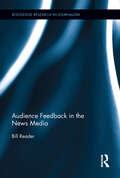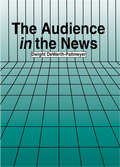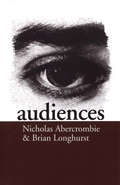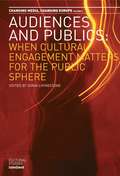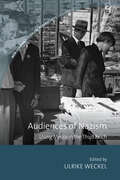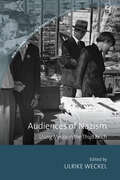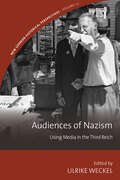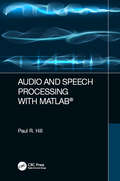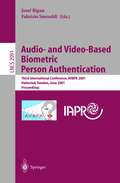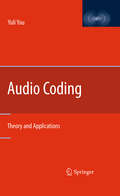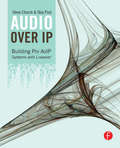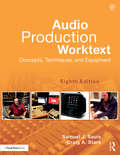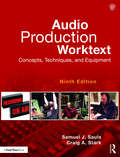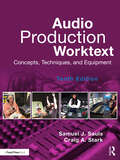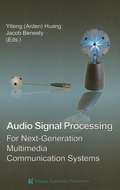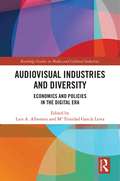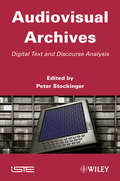- Table View
- List View
Audience Feedback in the News Media (Routledge Research in Journalism)
by Bill ReaderAs long as there has been news media, there has been audience feedback. This book provides the first definitive history of the evolution of audience feedback, from the early newsbooks of the 16th century to the rough-and-tumble online forums of the modern age. In addition to tracing the historical development of audience feedback, the book considers how news media has changed its approach to accommodating audience participation, and explores how audience feedback can serve the needs of both individuals and collectives in democratic society. Reader writes from a position of authority, having worked as a "letters to the editor" editor and has written numerous research articles and professional essays on the topic over the past 15 years.
Audience Feedback in the News Media (Routledge Research in Journalism)
by Bill ReaderAs long as there has been news media, there has been audience feedback. This book provides the first definitive history of the evolution of audience feedback, from the early newsbooks of the 16th century to the rough-and-tumble online forums of the modern age. In addition to tracing the historical development of audience feedback, the book considers how news media has changed its approach to accommodating audience participation, and explores how audience feedback can serve the needs of both individuals and collectives in democratic society. Reader writes from a position of authority, having worked as a "letters to the editor" editor and has written numerous research articles and professional essays on the topic over the past 15 years.
The Audience in the News (Routledge Communication Series)
by Dwight DeWerth-PallmeyerIn recent years, communication scholars have taken a renewed interest in analyzing the audience and its impact on the communication process. Similarly, news editors and producers have often turned toward a marketing orientation which seeks to give new readers and viewers what they want, or at least what they say they want. Yet, there has still been little written about just how the audience factors into the news which is produced. Seeking to fill that niche, this book argues that audience images are quite important in the construction of news, but not easily detected. That is because journalists are not principally interested in their audience; they are interested in the news. USE THIS PARAGRAPH ONLY FOR GENERAL CATALOGS... This volume argues that although journalistic images of the audience may be "incomplete," they do exist and powerfully help shape the work of journalists in producing journalistic texts. Using a case study of news workers and news texts at two Chicago newsgathering organizations, the Chicago Tribune and WGN-TV, this book: * examines notions of audience and how they have been treated by academicians, * presents a detailed description of the ways in which audience is embedded within the news construction process, * presents a very representative set of journalistic news values, * presents differing ideas of audience at three key levels of the news organizations -- reporters and news gatherers, editors and producers, and senior editors, producers, and news directors, and * seeks to summarize and position this study within the larger body of mass communication research.
The Audience in the News (Routledge Communication Series)
by Dwight DeWerth-PallmeyerIn recent years, communication scholars have taken a renewed interest in analyzing the audience and its impact on the communication process. Similarly, news editors and producers have often turned toward a marketing orientation which seeks to give new readers and viewers what they want, or at least what they say they want. Yet, there has still been little written about just how the audience factors into the news which is produced. Seeking to fill that niche, this book argues that audience images are quite important in the construction of news, but not easily detected. That is because journalists are not principally interested in their audience; they are interested in the news. USE THIS PARAGRAPH ONLY FOR GENERAL CATALOGS... This volume argues that although journalistic images of the audience may be "incomplete," they do exist and powerfully help shape the work of journalists in producing journalistic texts. Using a case study of news workers and news texts at two Chicago newsgathering organizations, the Chicago Tribune and WGN-TV, this book: * examines notions of audience and how they have been treated by academicians, * presents a detailed description of the ways in which audience is embedded within the news construction process, * presents a very representative set of journalistic news values, * presents differing ideas of audience at three key levels of the news organizations -- reporters and news gatherers, editors and producers, and senior editors, producers, and news directors, and * seeks to summarize and position this study within the larger body of mass communication research.
Audiences: A Sociological Theory of Performance and Imagination (PDF)
by Dr Brian Longhurst Professor Nick Abercrombie`This book is worth reading for a number of reasons. It is the first introductory work of critical audience research that suggests how we can study the connection of media consumption in general with every day life, and it also goes beyond its competitors in showing how postmodern thinking can help us in the analysis of a "whole way of life"' - Journal of Communication Audiences are problematic and the study of audiences has represented a key site of activity in the social sciences and humanities. Offering a timely review of the past 50 years of theoretical and methodological debate Audiences argues the case for a paradigmatic shift in audience research. This shift, argue the authors, is necessitated by the emergence of the `diffused audience'. Audience experience can no longer be simply classified as `simple' or `mass', for in modern advanced capitalist societies, people are members of an audience all the time. Being a member of an audience is no longer an exceptional event, nor even an everyday event, rather it is constitutive of everyday life. This book offers an invaluable review of the literature and a new point of departure for audience research.
Audiences And Publics: When Cultural Engagement Matters For The Public Sphere (Intellect Books - Changing Media, Changing Europe Ser. #Vol. 2)
by Sonia LivingstoneIn today’s thoroughly mass-mediated world, audiences and publics are, of course, composed of the same people. Yet social science traditionally treats them quite differently. Indeed, it is commonplace to define audiences in opposition to the public: in both popular and elite discourses, audiences are denigrated as trivial, passive, individualised, while publics are valued as active, critically engaged and politically significant.
Audiences of Nazism: Using Media in the Third Reich (New German Historical Perspectives #13)
by Ulrike WeckelThrough its focus on audiences and their reception of media in Nazi Germany, Audiences of Nazism inverts the typical top-down perspective employed in studies that concentrate on the regime’s regulation of media and propaganda. It thereby sheds new light on the complex character of the period’s media, their uses, and the scope for audience interpretation. Contributors investigate how consumers either appropriated or ignored certain messages of Nazi propaganda, and how some even participated in its production. The authors ground their studies on novel historical sources, including private diaries and letters, photographs and films, and concert programs, which demonstrate, amongst other things, how audiences interpreted and responded to regulated news, Nazi Party rallies, and the regime’s denunciation of modern works of art as ‘degenerate.’
Audiences of Nazism: Using Media in the Third Reich (New German Historical Perspectives #13)
by Ulrike WeckelThrough its focus on audiences and their reception of media in Nazi Germany, Audiences of Nazism inverts the typical top-down perspective employed in studies that concentrate on the regime’s regulation of media and propaganda. It thereby sheds new light on the complex character of the period’s media, their uses, and the scope for audience interpretation. Contributors investigate how consumers either appropriated or ignored certain messages of Nazi propaganda, and how some even participated in its production. The authors ground their studies on novel historical sources, including private diaries and letters, photographs and films, and concert programs, which demonstrate, amongst other things, how audiences interpreted and responded to regulated news, Nazi Party rallies, and the regime’s denunciation of modern works of art as ‘degenerate.’
Audiences of Nazism: Using Media in the Third Reich (New German Historical Perspectives #13)
Through its focus on audiences and their reception of media in Nazi Germany, Audiences of Nazism inverts the typical top-down perspective employed in studies that concentrate on the regime’s regulation of media and propaganda. It thereby sheds new light on the complex character of the period’s media, their uses, and the scope for audience interpretation. Contributors investigate how consumers either appropriated or ignored certain messages of Nazi propaganda, and how some even participated in its production. The authors ground their studies on novel historical sources, including private diaries and letters, photographs and films, and concert programs, which demonstrate, amongst other things, how audiences interpreted and responded to regulated news, Nazi Party rallies, and the regime’s denunciation of modern works of art as ‘degenerate.’
Audio and Speech Processing with MATLAB
by Paul HillSpeech and audio processing has undergone a revolution in preceding decades that has accelerated in the last few years generating game-changing technologies such as truly successful speech recognition systems; a goal that had remained out of reach until very recently. This book gives the reader a comprehensive overview of such contemporary speech and audio processing techniques with an emphasis on practical implementations and illustrations using MATLAB code. Core concepts are firstly covered giving an introduction to the physics of audio and vibration together with their representations using complex numbers, Z transforms and frequency analysis transforms such as the FFT. Later chapters give a description of the human auditory system and the fundamentals of psychoacoustics. Insights, results, and analyses given in these chapters are subsequently used as the basis of understanding of the middle section of the book covering: wideband audio compression (MP3 audio etc.), speech recognition and speech coding. The final chapter covers musical synthesis and applications describing methods such as (and giving MATLAB examples of) AM, FM and ring modulation techniques. This chapter gives a final example of the use of time-frequency modification to implement a so-called phase vocoder for time stretching (in MATLAB). Features A comprehensive overview of contemporary speech and audio processing techniques from perceptual and physical acoustic models to a thorough background in relevant digital signal processing techniques together with an exploration of speech and audio applications. A carefully paced progression of complexity of the described methods; building, in many cases, from first principles. Speech and wideband audio coding together with a description of associated standardised codecs (e.g. MP3, AAC and GSM). Speech recognition: Feature extraction (e.g. MFCC features), Hidden Markov Models (HMMs) and deep learning techniques such as Long Short-Time Memory (LSTM) methods. Book and computer-based problems at the end of each chapter. Contains numerous real-world examples backed up by many MATLAB functions and code.
Audio and Speech Processing with MATLAB
by Paul HillSpeech and audio processing has undergone a revolution in preceding decades that has accelerated in the last few years generating game-changing technologies such as truly successful speech recognition systems; a goal that had remained out of reach until very recently. This book gives the reader a comprehensive overview of such contemporary speech and audio processing techniques with an emphasis on practical implementations and illustrations using MATLAB code. Core concepts are firstly covered giving an introduction to the physics of audio and vibration together with their representations using complex numbers, Z transforms and frequency analysis transforms such as the FFT. Later chapters give a description of the human auditory system and the fundamentals of psychoacoustics. Insights, results, and analyses given in these chapters are subsequently used as the basis of understanding of the middle section of the book covering: wideband audio compression (MP3 audio etc.), speech recognition and speech coding. The final chapter covers musical synthesis and applications describing methods such as (and giving MATLAB examples of) AM, FM and ring modulation techniques. This chapter gives a final example of the use of time-frequency modification to implement a so-called phase vocoder for time stretching (in MATLAB). Features A comprehensive overview of contemporary speech and audio processing techniques from perceptual and physical acoustic models to a thorough background in relevant digital signal processing techniques together with an exploration of speech and audio applications. A carefully paced progression of complexity of the described methods; building, in many cases, from first principles. Speech and wideband audio coding together with a description of associated standardised codecs (e.g. MP3, AAC and GSM). Speech recognition: Feature extraction (e.g. MFCC features), Hidden Markov Models (HMMs) and deep learning techniques such as Long Short-Time Memory (LSTM) methods. Book and computer-based problems at the end of each chapter. Contains numerous real-world examples backed up by many MATLAB functions and code.
Audio- and Video-Based Biometric Person Authentication: Third International Conference, AVBPA 2001 Halmstad, Sweden, June 6-8, 2001. Proceedings (Lecture Notes in Computer Science #2091)
by Josef Bigun Fabrizio SmeraldiAudio Coding: Theory and Applications
by Yuli YouAudio Coding: Theory and Applications provides succinct coverage of audio coding technologies that are widely used in modern audio coding standards. Delivered from the perspective of an engineer, this book articulates how signal processing is used in the context of audio coding. It presents a detailed treatment of contemporary audio coding technologies and then uses the DRA audio coding standard as a practical example to illustrate how numerous technologies are integrated into a fully-fledged audio coding algorithm. Drawing upon years of practical experience and using numerous examples and illustrations Dr. Yuli You, gives a description of practical audio coding technologies including: • Designing high-performance algorithms that can be readily implemented on fixed-point or integer microprocessors. • How to properly implement an audio decoder on various microprocessors. Transient detection and adaptation of time-frequency resolution of subband filters. • Psychoacoustic models and optimal bit allocation. Audio Coding: Theory and Applications will be a valuable reference book for engineers in the consumer electronics industry, as well as students and researchers in electrical engineering.
Audio Over IP: Building Pro AoIP Systems with Livewire
by Steve Church Skip PizziPosition yourself at the forefront of audio and broadcast studio technology by learning audio over IP. You will gain knowledge of IP network engineering as it applies to audio applications, and then progress to a full understanding of how equipment built on Ethernet and Internet Protocol are used in today's audio production and broadcast facilities for the transporting, mixing and processing of pro-quality audio. A chapter on integrating Voice-over IP telephony (VoIP) to pro-audio and broadcast facilities is also included. Using the popular Livewire technology, you will learn how to design, construct, configure and troubleshoot an AoIP system, including how to interface with PCs, VoIP telephone PBXs, IP codecs, and the Internet. See how AoIP systems work in practice, and discover their distinct advantages over older audio infrastructures. With its complete introduction to AoIP technology in a fun, highly readable style, this book is essential for audio professionals who want to broaden their knowledge of IP-based studio systems--or for IT experts who need to understand AoIP applications.
Audio Over IP: Building Pro AoIP Systems with Livewire
by Steve Church Skip PizziPosition yourself at the forefront of audio and broadcast studio technology by learning audio over IP. You will gain knowledge of IP network engineering as it applies to audio applications, and then progress to a full understanding of how equipment built on Ethernet and Internet Protocol are used in today's audio production and broadcast facilities for the transporting, mixing and processing of pro-quality audio. A chapter on integrating Voice-over IP telephony (VoIP) to pro-audio and broadcast facilities is also included. Using the popular Livewire technology, you will learn how to design, construct, configure and troubleshoot an AoIP system, including how to interface with PCs, VoIP telephone PBXs, IP codecs, and the Internet. See how AoIP systems work in practice, and discover their distinct advantages over older audio infrastructures. With its complete introduction to AoIP technology in a fun, highly readable style, this book is essential for audio professionals who want to broaden their knowledge of IP-based studio systems--or for IT experts who need to understand AoIP applications.
Audio Production Worktext: Concepts, Techniques, and Equipment
by Samuel J. Sauls Craig A. StarkThis is an excellent introduction to the modern radio production studio, the equipment found in that studio, and the basic techniques needed to accomplish radio production work. The new edition is updated throughout and features new sections on mobile technology, audio editing apps and software, and digital editing, as well as updated graphics and expanded content on portable digital audio players. Features a worktext/website format tailored for both students and teachers, offering a solid foundation for anyone who wishes to know more about radio/audio equipment and production techniques.
Audio Production Worktext: Concepts, Techniques, and Equipment
by Samuel J. Sauls Craig A. StarkThis is an excellent introduction to the modern radio production studio, the equipment found in that studio, and the basic techniques needed to accomplish radio production work. The new edition is updated throughout and features new sections on mobile technology, audio editing apps and software, and digital editing, as well as updated graphics and expanded content on portable digital audio players. Features a worktext/website format tailored for both students and teachers, offering a solid foundation for anyone who wishes to know more about radio/audio equipment and production techniques.
Audio Production Worktext: Concepts, Techniques, and Equipment
by Samuel J. Sauls Craig A. StarkAudio Production Worktext, 9th Edition provides readers the best introduction to audio and radio production. It shows how to navigate modern radio production studios and utilize the latest equipment and software. The 9th edition is updated to cover new mobile technologies, digital consoles, and audio editing apps and software, as well sound for the visual media and Internet radio. The new edition continues to include the worktext/website format tailored for both students and teachers and features like Production Tips that provide notes relevant to various audio production topics, self-study questions and projects, an updated Glossary, and an up-to-date companion website with invaluable student and instructor materials. Included in this edition are offers and features from Pro Sound Effects, FilmTVsound.com, and RadioFX, as well as updated color graphics and images throughout the text.
Audio Production Worktext: Concepts, Techniques, and Equipment
by Samuel J. Sauls Craig A. StarkAudio Production Worktext, 9th Edition provides readers the best introduction to audio and radio production. It shows how to navigate modern radio production studios and utilize the latest equipment and software. The 9th edition is updated to cover new mobile technologies, digital consoles, and audio editing apps and software, as well sound for the visual media and Internet radio. The new edition continues to include the worktext/website format tailored for both students and teachers and features like Production Tips that provide notes relevant to various audio production topics, self-study questions and projects, an updated Glossary, and an up-to-date companion website with invaluable student and instructor materials. Included in this edition are offers and features from Pro Sound Effects, FilmTVsound.com, and RadioFX, as well as updated color graphics and images throughout the text.
Audio Production Worktext: Concepts, Techniques, and Equipment
by Samuel J. Sauls Craig A. StarkNow in its tenth edition, the Audio Production Worktext offers a comprehensive introduction to audio production in radio, television, and film. This hands-on, student-friendly text demonstrates how to navigate modern radio production studios and utilize the latest equipment and software. Key chapters address production planning, the use of microphones, audio consoles, and sound production for the visual media. The reader is shown the reality of audio production both within the studio and on location. New to this edition is material covering podcasting, including online storage and distribution. The new edition also includes an updated glossary and appendix on analog and original digital applications, as well as self-study questions and projects that students can use to further enhance their learning. The accompanying instructor website has been refreshed and includes an instructor’s manual and PowerPoint images. This book remains an essential text for audio and media production students seeking a thorough introduction to the field.
Audio Production Worktext: Concepts, Techniques, and Equipment
by Samuel J. Sauls Craig A. StarkNow in its tenth edition, the Audio Production Worktext offers a comprehensive introduction to audio production in radio, television, and film. This hands-on, student-friendly text demonstrates how to navigate modern radio production studios and utilize the latest equipment and software. Key chapters address production planning, the use of microphones, audio consoles, and sound production for the visual media. The reader is shown the reality of audio production both within the studio and on location. New to this edition is material covering podcasting, including online storage and distribution. The new edition also includes an updated glossary and appendix on analog and original digital applications, as well as self-study questions and projects that students can use to further enhance their learning. The accompanying instructor website has been refreshed and includes an instructor’s manual and PowerPoint images. This book remains an essential text for audio and media production students seeking a thorough introduction to the field.
Audio Signal Processing for Next-Generation Multimedia Communication Systems
by Jacob Benesty Yiteng Arden HuangAudio Signal Processing for Next-Generation Multimedia Communication Systems presents cutting-edge digital signal processing theory and implementation techniques for problems including speech acquisition and enhancement using microphone arrays, new adaptive filtering algorithms, multichannel acoustic echo cancellation, sound source tracking and separation, audio coding, and realistic sound stage reproduction. This book's focus is almost exclusively on the processing, transmission, and presentation of audio and acoustic signals in multimedia communications for telecollaboration where immersive acoustics will play a great role in the near future.
Audio-Visual Industries and Diversity: Economics and Policies in the Digital Era (Routledge Studies in Media and Cultural Industries)
by Luis A. Albornoz Mª Trinidad García LeivaThis book reflects critically on issues of diversity, access, and the expansion of digital technologies in audio-visual industries, particularly in terms of economics and policies. It brings together specialists in cultural diversity and media industries, presenting an international and interdisciplinary collection of essays that draw from different fields of studies – notably Communication, Economics, Political Science and Law. Among the topics discussed are: the principle of diversity as a goal of cultural and communication policies, the assessment of the UNESCO Convention on Cultural Diversity, free trade agreements and the conception of cultural goods and services they advance, the challenges faced by the production, circulation and consumption of cultural content through the Internet, the role algorithms play in the organization and functioning of online platforms, Netflix and the hegemony of global media. The approach is a critical understanding of audio-visual diversity, that aims to transcend specific issues like media ownership, ideas portrayed or modes of consumption as such, to focus on a more balanced distribution of communicative power. This volume is an essential read for scholars and researchers in Communication Studies, Economy of Culture, International Relations and International Law, as well as policy makers, journalists specialized in media and culture, and managers of public and private institutions involved in the development of cultural and communication policies. Postgraduate students will find it a key reference point.
Audio-Visual Industries and Diversity: Economics and Policies in the Digital Era (Routledge Studies in Media and Cultural Industries)
by Luis A. Albornoz Ma. Trinidad García LeivaThis book reflects critically on issues of diversity, access, and the expansion of digital technologies in audio-visual industries, particularly in terms of economics and policies. It brings together specialists in cultural diversity and media industries, presenting an international and interdisciplinary collection of essays that draw from different fields of studies – notably Communication, Economics, Political Science and Law. Among the topics discussed are: the principle of diversity as a goal of cultural and communication policies, the assessment of the UNESCO Convention on Cultural Diversity, free trade agreements and the conception of cultural goods and services they advance, the challenges faced by the production, circulation and consumption of cultural content through the Internet, the role algorithms play in the organization and functioning of online platforms, Netflix and the hegemony of global media. The approach is a critical understanding of audio-visual diversity, that aims to transcend specific issues like media ownership, ideas portrayed or modes of consumption as such, to focus on a more balanced distribution of communicative power. This volume is an essential read for scholars and researchers in Communication Studies, Economy of Culture, International Relations and International Law, as well as policy makers, journalists specialized in media and culture, and managers of public and private institutions involved in the development of cultural and communication policies. Postgraduate students will find it a key reference point.
Audiovisual Archives: Digital Text and Discourse Analysis
by Peter StockingerToday, audiovisual archives and libraries have become very popular especially in the field of collecting, preserving and transmitting cultural heritage. However, the data in these archives or libraries - videos, images, soundtracks, etc. - constitute as such only potential cognitive resources for a given public (or “target community”). One of the most crucial issues of digital audiovisual libraries is indeed to enable users to actively appropriate audiovisual resources for their own concern (in research, education or any other professional or non-professional context). This means, an adaptation of the audiovisual data to the specific needs of a user or user group can be represented by small and closed "communities" as well as by networks of open communities around the globe. "Active appropriation" is, basically speaking, the use of existing digital audiovisual resources by users or user communities according to their expectations, needs, interests or desires. This process presupposes: 1) the definition and development of models or "scenarios" of cognitive processing of videos by the user; 2) the availability of tools necessary for defining, developing, reusing and sharing meta-linguistic resources such as thesauruses, ontologies or description models by users or user communities. Both aspects are central to the so-called semiotic turn in dealing with digital (audiovisual) texts, corpora of texts or again entire (audiovisual) archives and libraries. They demonstrate practically and theoretically the well-known “from data to metadata” or “from (simple) information to (relevant) knowledge” problem, which obviously directly influences the effective use, social impact and relevancy, and therefore also the future, of digital knowledge archives. This book offers a systematic, comprehensive approach to these questions from a theoretical as well as practical point of view. Contents Part 1. The Practical, Technical and Theoretical Context 1. Analysis of an Audiovisual Resource. 2. The Audiovisual Semiotic Workshop (ASW) Studio – A Brief Presentation. 3. A Concrete Example of a Model for Describing Audiovisual Content. 4. Model of Description and Task of Analysis. Part 2. Tasks in Analyzing an Audiovisual Corpus 5. The Analytical Task of “Describing the Knowledge Object”. 6. The Analytical Task of “Contextualizing the Domain of Knowledge”. 7. The Analytical Task of “Analyzing the Discourse Production around a Subject”. Part 3. Procedures of Description 8. Definition of the Domain of Knowledge and Configuration of the Topical Structure. 9. The Procedure of Free Description of an Audiovisual Corpus. 10. The Procedure of Controlled Description of an Audiovisual Corpus. Part 4. The ASW System of Metalinguistic Resources 11. An Overview of the ASW Metalinguistic Resources. 12. The Meta-lexicon Representing the ASW Universe of Discourse.
